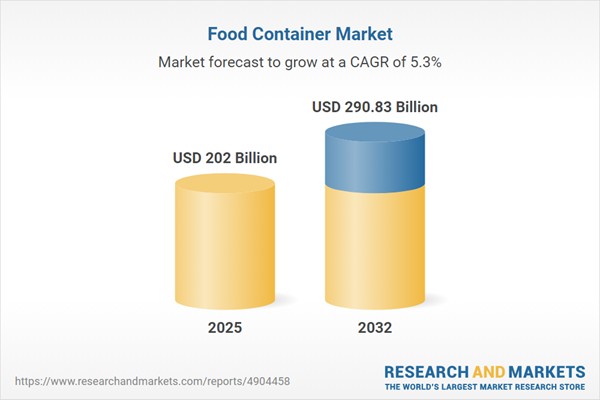Speak directly to the analyst to clarify any post sales queries you may have.
The food container market is evolving rapidly as sustainability, digital traceability, and new regulatory demands prompt senior leaders to recalibrate strategies. Companies in this space are responding to rising expectations for convenience, safety, and environmentally responsible packaging while addressing technological innovations and shifting global supply chains.
Market Snapshot: Food Container Market Size and Growth
The food container market is experiencing sustained expansion, with growth underpinned by consumer shifts toward convenience, tighter regulatory controls, and heightened focus on eco-friendly solutions. Businesses are investing in product advancements and digital infrastructure to maintain competitiveness in an environment defined by regulatory change and global trade pressures. Strategic supply chain adaptations, material innovations, and the proliferation of e-commerce channels are key contributors to the sector’s upward trajectory. Senior decision-makers are monitoring these movements closely as markets in North America, Europe, Asia-Pacific, and the Americas shape global growth patterns, and established players adapt to increasing competition from agile, tech-forward entrants.
Scope & Segmentation of the Global Food Container Market
- Material Types: Ceramics (porcelain, stoneware), Glass, Metal (aluminum, steel), Paperboard, Plastics (polyethylene, polypropylene, polyvinyl chloride).
- Product Formats: Boxes & cartons, cans, cups & tubes, jars & bottles, pouches & bags span traditional, refillable, and flexible applications.
- Usage Modes: Single-use containers and reusable options serve a broad array of convenience and sustainability requirements.
- Applications: Solutions cover bakery & confectionery, dairy, fruits & vegetables (fresh and frozen), meat & seafood (fresh and processed), and ready-to-eat segments (pre-cooked meals and snacks).
- End Users: Includes the food processing industry, food service outlets (cafeterias, restaurants), households, and retail/supermarket channels.
- Distribution Channels: Offline outlets (wholesale, brick-and-mortar retail) and online direct-to-consumer platforms.
- Regional Coverage: Americas (North and Latin America), Europe, Middle East & Africa, Asia-Pacific, reflecting mature and emerging markets.
- Key Technologies: Smart packaging, digital traceability systems, material simulation, and advanced, sustainable substrates.
Key Takeaways for Senior Decision-Makers
- Innovations in digital traceability, including blockchain and real-time freshness monitoring, are redefining operational standards and improving quality assurance.
- Advanced material adoption, such as bio-based and compostable polymers, is gaining momentum as firms align with circular economy initiatives and regulatory mandates.
- Supply chain resilience is becoming a strategic lever; leaders are pursuing local sourcing, multi-supplier networks, and automation to offset global uncertainty and tariff impacts.
- Direct-to-consumer trends via e-commerce are influencing design, with a focus on durability, tamper-evidence, and efficient shipping ratios to support online grocery and meal kit models.
- Mergers, acquisitions, and strategic alliances with startups are expanding sustainability and technology portfolios, as established players seek differentiation through integrated production and recycling capabilities.
- Regional approaches vary, with mature North American and European markets investing in recycling and lightweighting, while emerging markets prioritize cost-efficient flexible packaging for logistics and climate diversity.
Tariff Impact on Food Container Supply Chains
Recent changes in US tariff schedules are affecting sourcing strategies and supplier negotiations. Higher duties on imported metals and plastics are prompting producers to reassess global partners, expand domestic operations, and invest in supply flexibility. As pricing complexity grows, operational budgets are under review, and collaborative sourcing arrangements—such as joint ventures and long-term contracts—are emerging to mitigate risks and optimize costs across regions.
Methodology & Data Sources
This report employs a mixed-methods approach, integrating secondary research with direct fieldwork and expert interviews. Quantitative data from authoritative trade sources, patents, and industry reports is complemented by stakeholder insights collected through surveys and structured questionnaires. Rigorous triangulation, time-series analysis, and scenario modeling underpin the reliability of the findings for sector leaders.
Why This Report Matters
- Enables proactive decision-making by highlighting early-stage technological trends, regulatory changes, and supply chain innovations specific to food containers.
- Equips senior teams to identify regional growth opportunities, optimize sourcing strategies, and future-proof operations against evolving trade and sustainability pressures.
Conclusion
The food container market is being reshaped by technology, regulation, and consumer expectations. Leaders who prioritize sustainability, digital agility, and adaptive sourcing will position their organizations for long-term resilience and growth within this dynamic sector.
Additional Product Information:
- Purchase of this report includes 1 year online access with quarterly updates.
- This report can be updated on request. Please contact our Customer Experience team using the Ask a Question widget on our website.
Table of Contents
3. Executive Summary
4. Market Overview
7. Cumulative Impact of Artificial Intelligence 2025
Companies Mentioned
The companies profiled in this Food Container market report include:- Amcor PLC
- Asahi Kasei Corporation
- Ball Corporation
- Berry Global, Inc.
- Crown Holdings Incorporated
- Fuling Global Inc.
- Gerresheimer AG
- Kaneka Corporation
- Mitsubishi Chemical Corporation
- Mondi Group
Table Information
| Report Attribute | Details |
|---|---|
| No. of Pages | 184 |
| Published | November 2025 |
| Forecast Period | 2025 - 2032 |
| Estimated Market Value ( USD | $ 202 Billion |
| Forecasted Market Value ( USD | $ 290.83 Billion |
| Compound Annual Growth Rate | 5.3% |
| Regions Covered | Global |
| No. of Companies Mentioned | 11 |









